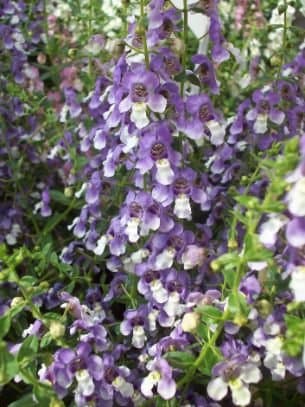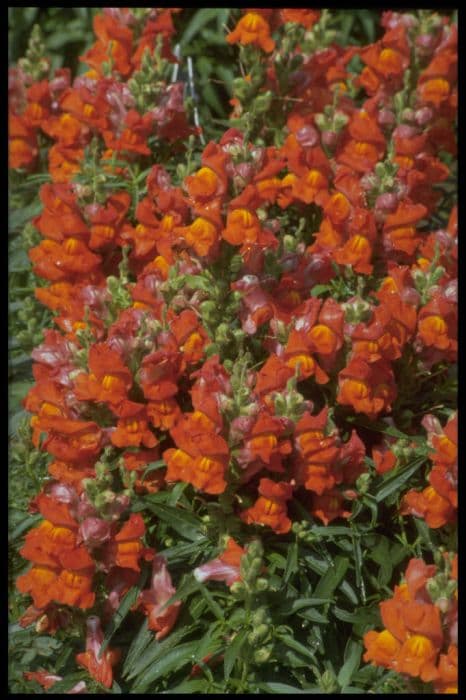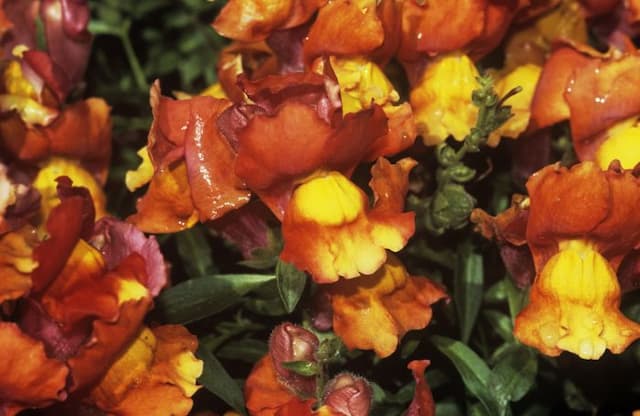Prostrate Speedwell Veronica prostrata

ABOUT
Veronica prostrata, commonly known as prostrate speedwell, is a ground-covering perennial that is admired for its decorative qualities. This plant is characterized by its spreading mats of foliage that consist of small, oval to lance-shaped leaves. The leaves are typically bright green and may have a slightly serrated edge, providing a lush and dense carpet of color in gardens. During its blooming season, prostrate speedwell produces abundant, tiny flowers that can be appreciated for their delicate beauty. These blossoms are usually a vivid shade of blue and are arranged in tight clusters on slender, upright stems that arise from the foliage below. The individual flowers have a distinct shape with four petals, the lowermost of which is often slightly larger than the others, giving them a charming and slightly asymmetrical appearance. The vibrant blossoms of the prostrate speedwell not only add a splash of color but also attract pollinators such as bees, which are drawn to the nectar and pollen. After the flowering season, the plant continues to offer visual interest with its dense foliage, making it a favorite choice for gardeners who are looking to add texture and ground cover to their landscapes.
About this plant
 Names
NamesFamily
Plantaginaceae
Synonyms
Prostrate Speedwell, Creeping Speedwell
Common names
Veronica rupestris, Veronica prostrata var. prostrata, Veronica prostrata var. rupestris, Veronica prostrata var. scheereri.
 Toxicity
ToxicityTo humans
Veronica prostrata, commonly known as prostrate speedwell, is generally considered non-toxic to humans. There are no well-documented cases of poisoning from this plant for humans, and it is not known to contain any toxic compounds that would cause serious harm if ingested. However, as with any plant, individual allergies or sensitivities could cause mild irritation or an allergic reaction, so it's always prudent not to consume plant parts unless they are known to be safe and are prepared correctly.
To pets
Prostrate speedwell is not recognized as a toxic plant for pets either. It does not contain known toxins that would cause serious harm to dogs, cats, or other domestic animals if they were to ingest it. As always, pets may have individual sensitivities or allergies, and eating non-food plants can sometimes lead to gastrointestinal upset such as vomiting or diarrhea due to the plant material's physical properties rather than its chemical makeup. It's still a good practice to monitor pets and prevent them from eating plants that are not part of their regular diet.
 Characteristics
CharacteristicsLife cycle
Perennials
Foliage type
Deciduous
Color of leaves
Green
Flower color
Blue
Height
0.5 feet (15 cm)
Spread
1.5 feet (45 cm)
Plant type
Herb
Hardiness zones
4
Native area
Europe
Benefits
 General Benefits
General Benefits- Low Maintenance: Veronica prostrata, commonly known as Prostrate Speedwell, requires minimal care once established, making it a good choice for gardens without a lot of time for upkeep.
- Drought Tolerance: Prostrate Speedwell is relatively drought resistant, which can be particularly beneficial in areas with water restrictions or low rainfall.
- Erosion Control: Its mat-forming habit can help stabilize soil and prevent erosion on slopes or banks.
- Attracts Pollinators: The flowers of Prostrate Speedwell attract bees and butterflies, supporting pollinator populations and biodiversity in the garden.
- Aesthetic Appeal: With its attractive foliage and blue to violet flowers, it adds color and beauty to garden landscapes.
- Ground Cover: Its low, spreading growth habit makes it an excellent ground cover, filling in spaces and suppressing weeds.
- Edging Plant: Due to its compact size, Prostrate Speedwell is often used as a border or edging plant along paths and garden beds.
- Rock Gardens: It is well-suited for rock gardens or alpine settings due to its ability to thrive in well-draining soil and its low-profile form.
 Medical Properties
Medical Properties- Anti-inflammatory: Veronica prostrata has been traditionally used to reduce inflammation.
- Diuretic: It may sometimes be used for its diuretic properties to help with urinary issues.
- Gastrointestinal aid: It may provide relief from certain gastrointestinal discomforts.
- Skin conditions: Sometimes employed in the treatment of eczema and other skin conditions due to its supposed soothing properties.
 Air-purifying Qualities
Air-purifying QualitiesThis plant is not specifically known for air purifying qualities.
 Other Uses
Other Uses- Ground Cover: Veronica prostrata, also known as prostrate speedwell, is used as a ground cover in gardens and parks due to its low-growing habit and ability to spread, creating a dense mat that can suppress weeds.
- Erosion Control: The plant's dense growth helps stabilize soil on slopes and banks, making it a good candidate for erosion control projects.
- Aesthetic Edging: Prostrate speedwell is used as edging along garden paths and flower beds as it provides a neat, low border and adds a splash of color when in bloom.
- Rock Gardens: It’s ideal for rock gardens because of its tolerance to dry conditions and capability to grow in the crevices between stones.
- Green Roof Planting: Veronica prostrata can be used in green roofing due to its hardiness and low maintenance, contributing to biodiversity and the aesthetic of green roofs.
- Butterfly Gardens: The flowers attract butterflies and other pollinators, making it a valuable addition to butterfly gardens.
- Live Mulch: Its dense foliage can act as live mulch, helping to maintain soil moisture and temperature, and reduce the growth of unwanted plants.
- Container Gardening: Prostrate speedwell can be grown in containers, where its trailing stems can create a cascading effect over the sides of pots.
- Fairy Gardens: Owing to its petite size and delicate flowers, it's well-suited for use in whimsical fairy garden designs.
- Lawn Alternative: In areas with light foot traffic, prostrate speedwell can serve as a low-maintenance and decorative lawn alternative.
Interesting Facts
 Feng Shui
Feng ShuiThe Speedwell is not used in Feng Shui practice.
 Zodiac Sign Compitability
Zodiac Sign CompitabilityThe Speedwell is not used in astrology practice.
 Plant Symbolism
Plant Symbolism- Healing: Veronica prostrata, commonly known as the Prostrate Speedwell, has been associated with healing due to its use in traditional medicine, symbolizing the body's ability to recover and mend.
- Fidelity: In the language of flowers, speedwell represents faithfulness and enduring love, making it a symbol of unwavering devotion in relationships.
- Clarity: The clear blue of the Prostrate Speedwell's flowers is often seen as a symbol of clarity and truthful expression, encouraging clear communication and thought.
- Persistence: Given its spreading habit and resilience, this plant symbolizes persistence and the ability to thrive in challenging conditions.
 Water
WaterThe creeping speedwell should be watered deeply but infrequently, allowing the soil to dry out somewhat between waterings as it prefers moderately dry conditions. Aim for about one inch of water per week, which equates to around 0.5 gallons per square foot of soil. Overwatering can lead to root rot, so ensure that the plant is in well-draining soil and reduce watering frequency during the winter months when the plant's growth slows down.
 Light
LightCreeping speedwell thrives in full sun to partial shade. For optimal growth, place it in a location where it receives at least six hours of sunlight per day. However, in extremely hot climates, some afternoon shade can be beneficial to prevent scorching. Avoid deep shade as this can lead to leggy growth and fewer flowers.
 Temperature
TemperatureCreeping speedwell is hardy and can handle temperatures as low as -30 degrees Fahrenheit and as high as 85 degrees Fahrenheit. However, its ideal growing temperatures are between 60 and 70 degrees Fahrenheit. Make sure to plant it in an area that avoids the extreme cold to ensure its survival through winter months.
 Pruning
PruningCreeping speedwell can be pruned to control its spread and to maintain a compact, neat appearance, which promotes healthier growth and more vigorous flowering. The best time to prune is in early spring or after the flowering period in late spring or early summer. Regularly trimming back the tips of the stems can encourage bushier growth. Pruning should be done as often as needed to maintain the desired shape and size.
 Cleaning
CleaningAs needed
 Soil
SoilThe best soil mix for Speedwell (Veronica prostrata) should be well-draining and rich in organic matter, with a pH between 6.0 and 7.0. A mix of garden soil, compost, and perlite or sand can provide the appropriate structure and nutrients.
 Repotting
RepottingSpeedwell generally does not need frequent repotting and can be repotted every 2-3 years or when it outgrows its current container.
 Humidity & Misting
Humidity & MistingSpeedwell thrives in average ambient humidity and does not require any special humidity requirements; typical indoor levels are usually sufficient.
 Suitable locations
Suitable locationsIndoor
Place Speedwell near a sunny window and ensure good air circulation.
Outdoor
Plant Speedwell in full sun to part shade and well-draining soil.
Hardiness zone
3-8 USDA
 Life cycle
Life cycleVeronica prostrata, commonly known as prostrate speedwell, begins its life cycle as a seed, which germinates when conditions of moisture, temperature, and light are favorable. The seedling emerges and develops into a mat-forming perennial with a rosette of leaves at the base. As it matures, the prostrate speedwell will produce stems that spread out along the ground and root at the nodes, forming clumps of foliage. Flowering occurs in late spring to early summer, presenting small blue to violet flowers important for pollination and eventual seed production. After pollination, the flowers produce small capsule-like fruits containing seeds, completing the reproductive cycle. During winter or unfavorable conditions, the aboveground parts may die back, but the plant can survive as a perennial through its root system, ready to regrow when conditions improve.
 Propogation
PropogationPropogation time
Spring to early summer
For the Speedwell (Veronica prostrata), the most popular method of propagation is through division. This should ideally be done in the early spring or fall. To propagate through division, gently lift the parent plant from the soil, ensuring to keep a good amount of root system intact with each portion. Using a sharp spade or knife, divide the plant into smaller clumps, each with several shoots and a portion of the root system. These divisions can then be replanted at the same depth they were growing at originally, spaced approximately 9 to 12 inches (23 to 30 cm) apart to allow for growth. It is important to water the new divisions thoroughly after planting to help establish them. This method of propagation is quick and often results in flowering plants within the same season.









